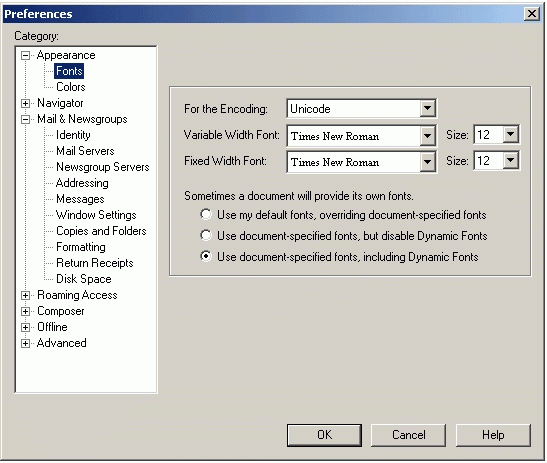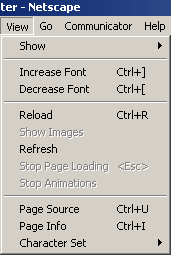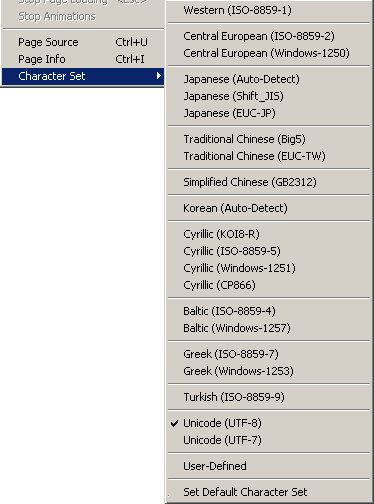Font Selection: It is necessary to select
a font that is able to display Unicode characters.
Andalus, Arial Unicode MS, Arabic Simplified, Arabic
Transparent, Lucida Sans Unicode, Microsoft Sans Serif,
Tahoma, Times New Roman, and Traditional Arabic are able to
display some of the Unicode fonts. Arial Unicode MS font
displays a very wide range of Unicode characters. For
most Arabic text viewing, Arabic Transparent or Traditional
Arabic fonts should be suitable.
However, if you experience any difficulties, Arial Unicode
MS font should be tried. The Times New Roman font that
came with Windows 2000 displayed is a Unicode capable font,
and it displays Arabic, English, Greek, and Hebrew fonts
nicely.
Netscape Font Selection: First, click the mouse on
Edit.
Second, click the mouse on Preferences.

Third, click the mouse on Fonts under Appearance.
Then select Unicode Encoding and a Unicode compatible font.
Select a font that displays the appropriate target language or
languages.
Fourth, click the mouse on OK to finalize the selection.
Character Set: Next, it is necessary to select a
Character Set that includes the Arabic Unicode number
range. Often, Unicode(UTF-8) will be satisfactory.
First, click the mouse on View .

Second, click the mouse on Character Set. Third,
click the mouse on Unicode (UTF-8). Fourth, click the
mouse on Set Default Character Set. This assures that
Unicode (UTF-8) will remain after the program is restarted.

Finally, click the mouse on Reload to activate the new
settings.

After Netscape has a Unicode compatible font, and the
Character Set is Unicode (UTF-8), the Arabic fonts should
display properly.
Test settings: There are a couple of
sites that have Unicode font pages. The Unicode decimal
number range for Arabic is 1536-1791,
64336-65023,
and 65136-65279.
If Netscape has been properly configured, the Arabic fonts
should display properly.
Another web site has an excellent chart of the decimal
number ranges of Unicode. The 1001-2000
, 64001-64999
, and 65001-65536
Hopefully, these comments and pictures will provide you
with enough information so that you will be able to view
Arabic Unicode text. A similar procedure is followed to
display Greek and Hebrew Unicode characters. First
select a Unicode font and then select the appropriate Encoding
scheme. Finally, test the settings by viewing a page
that has the appropriate decimal number for the Unicode
language fonts.
Normal settings: To return to your normal
settings, select the Western (ISO-8859-1) Character Set and
the font of your choice. However, if you have chosen a
Unicode font that can display all of the languages that you
plan to view, you can leave your browser's configuration set
to view Unicode fonts.
There is additional help for Netscape users at
Allan Wood's site.
If there are difficulties with these browser and email
configurations suggestions, please let me know. I have
not been able to do many tests.
Last edited 06-11-2000
